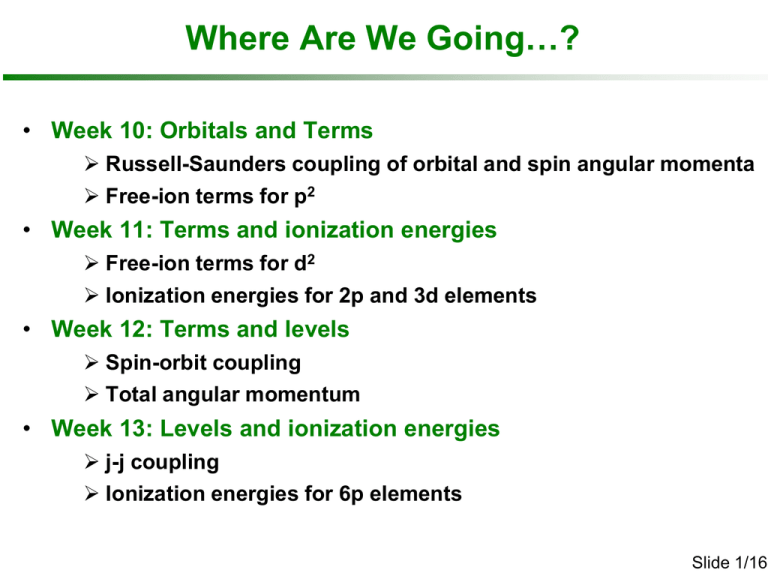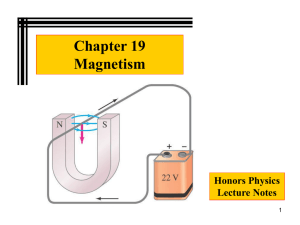Document
advertisement

Where Are We Going…? • Week 10: Orbitals and Terms Russell-Saunders coupling of orbital and spin angular momenta Free-ion terms for p2 • Week 11: Terms and ionization energies Free-ion terms for d2 Ionization energies for 2p and 3d elements • Week 12: Terms and levels Spin-orbit coupling Total angular momentum • Week 13: Levels and ionization energies j-j coupling Ionization energies for 6p elements Slide 1/16 Many Electron Atoms • For any 2 e- atom or ion, the Schrödinger equation cannot be solved for every electron: HH-like = S ½ mvi2 + S - Ze ri i • i Treatment leads to configurations for example: He 1s2, C 1s2 2s2 2p2 • Inclusion of interelectron repulsion leads to terms for example: p2 1D, 3F and 1S characterized by S and L quantum numbers energy given by Hund’s 1st and 2nd rules (2S+1)(2L+1) degenerate Si≠j e2 rij Magnetism Due To Spin • Electron(s) with spin angular momentum generate a magnetic field perpendicular to plane of loop magnitude related to S direction related to MS Slide 3/16 Magnetism Due To Orbit • Electron(s) with orbital angular momentum generate a magnetic field perpendicular to plane of loop magnitude related to L direction related to ML Slide 4/16 Orbital Magnetism • • Electrons generate magnetism through their orbital motion This is associated with an ability to rotate an orbital about an axis into an identical and degenerate orbital. z z y y x x rotation of a px orbital by 90° gives a py orbital and vice versa: generating magnetism about the z-direction Orbital Magnetism rotation of a px orbital by 90° gives a py orbital and vice versa: generating magnetism about the z-direction • To be able to do this: the orbitals involved must have the same energy there must not be an electron in the second orbital with the same spin as that in the first orbital. If there is, the electron cannot orbit without breaking the Pauli principle. free orbitals available for electron to hop into: orbital magnetism free orbital available for electron to hop into: orbital magnetism L=1 L=1 no free orbital available for electron to hop into: no orbital magnetism L=0 Slide 6/16 Spin Orbit Coupling • There is a magnetic interaction between the magnetism generated by the spin and orbital motions results in different values for the total angular momentum, J orbital magnetism lowest energy spin magnetism highest energy Slide 7/16 Russell – Saunders Coupling • The magnetic interaction increases with the atomic number for most of the periodic table, electrostatic >> magnetic • Treat electrostatic to give terms characterized by L and S l1 + l2 + … = L, s1 + s2 + … = S • Then treat spin-orbit second to give levels: L+S=J J is the total angular momentum H = HH-like + configurations Si≠j e2 rij terms + λL.S levels Russell – Saunders Coupling • For each L and S value: J = L + S, L + S – 1, L + S – 2 …. L – S Each level, MJ = J, J -1, J - 2, … -J (2J+1 values) 2S+1 LJ Slide 9/16 Hund’s 3rd Rule • For less than half-filled shells, smallest J lies lowest p2: ground term is 3P with S = 1 and L = 1 J = 2, 1 and 0 less than half-filled: 3P 2 3P 3P 1 3P 0 Slide 10/16 Hund’s 3rd Rule • For more than half-filled shells, highest J lies lowest p4: ground term is 3P with S = 1 and L = 1 J = 2, 1 and 0 more than half-filled: 3P 0 3P 3P 1 3P 2 Slide 11/16 Magnetism • The magnetic moment is given by: 1 μeff g[J(J 1)] 2 where g is the Landé splitting factor, 3 g 2 • [S(S 1) L(L 1)] 2J(J 1) p2: ground level is 3P0 with J = 0, S = 1, L = 1 μeff = 0 (p2 is diamagnetic, at least at low temperature) • p4: ground level is 3P2 with J = 2, S = 1, L = 1 g = 3/2 and μeff = 3.68 B.M. (B.M. = “Bohr Magnetons”) Slide 12/16 Ionization Energies: (iii) Hund’s 3rd Rule p-block ionization energies: M M+ ionization energy energy (eV) (eV) ionization 12 25 11 20 10 2p 6p 15 9 3p 4p 5p 6p 8 10 7 5 6 50 11 • 22 33 ppnn 44 55 66 For 6p, there is a decrease between p2 and p3 No half-filled shell effect! Slide 13/16 j-j Coupling • For very heavy elements, magnetic coupling becomes large • Treat spin-orbit first to give spin-orbitals for each electron: j = l + s each value is (2j+1) degenerate • Then add individual j values together to give J j1 + j2 + … = J • For p-electrons, l = 1 and s = 1/2 j = 1/2 and 3/2 with former lowest in energy j = 3/2 j = 1/2 Slide 14/16 j-j Coupling • For p-electrons, l = 1 and s = 1/2 j = 1/2 and 3/2 with former lowest in energy j = 3/2 j = 1/2 • If electrostatic >> magnetic overall increase due to increasing nuclear charge decrease in ionization energy for p4 due to pairing (1st rule) • If magnetic > electrostatic overall increase due to increasing nuclear charge decrease in ionization energy for p3 due to repulsive magnetic interaction (3rd rule) Slide 15/16 Summary Spin and orbital magnetism • Electrons have intrinsic magnetism due to spin • Electrons may also have orbital magnetism Spin-orbit coupling • Usually weak magnetic coupling between spin and orbit • Characterized by levels with total angular momentum, J Hund’s 3rd Rule • Lowest J lies lowest for < 1/2 filled shells • Highest J lies lowest for > 1/2 filled shells Consequences • Magnitude of magnetism due to J, L and S • Stabilization of p1 and p2, destabilization of p4 – p6 Task! • Work out ground levels and magnetism for fn elements






